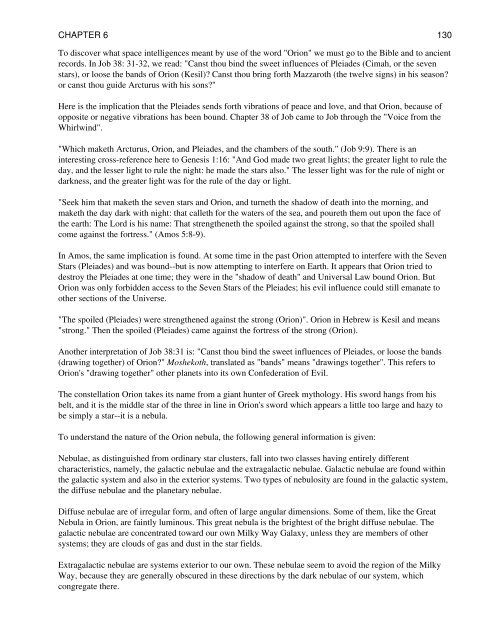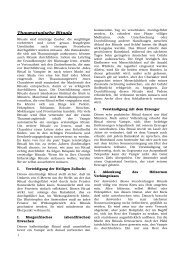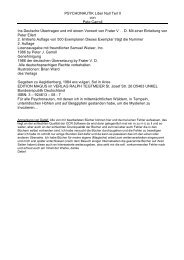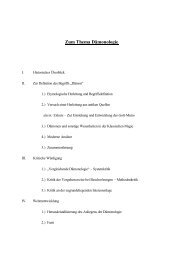CHAPTER 2 CHAPTER 3 CHAPTER 1 CHAPTER 2 CHAPTER 3 ...
CHAPTER 2 CHAPTER 3 CHAPTER 1 CHAPTER 2 CHAPTER 3 ...
CHAPTER 2 CHAPTER 3 CHAPTER 1 CHAPTER 2 CHAPTER 3 ...
You also want an ePaper? Increase the reach of your titles
YUMPU automatically turns print PDFs into web optimized ePapers that Google loves.
<strong>CHAPTER</strong> 6 130<br />
To discover what space intelligences meant by use of the word "Orion" we must go to the Bible and to ancient<br />
records. In Job 38: 31-32, we read: "Canst thou bind the sweet influences of Pleiades (Cimah, or the seven<br />
stars), or loose the bands of Orion (Kesil)? Canst thou bring forth Mazzaroth (the twelve signs) in his season?<br />
or canst thou guide Arcturus with his sons?"<br />
Here is the implication that the Pleiades sends forth vibrations of peace and love, and that Orion, because of<br />
opposite or negative vibrations has been bound. Chapter 38 of Job came to Job through the "Voice from the<br />
Whirlwind".<br />
"Which maketh Arcturus, Orion, and Pleiades, and the chambers of the south." (Job 9:9). There is an<br />
interesting cross-reference here to Genesis 1:16: "And God made two great lights; the greater light to rule the<br />
day, and the lesser light to rule the night: he made the stars also." The lesser light was for the rule of night or<br />
darkness, and the greater light was for the rule of the day or light.<br />
"Seek him that maketh the seven stars and Orion, and turneth the shadow of death into the morning, and<br />
maketh the day dark with night: that calleth for the waters of the sea, and poureth them out upon the face of<br />
the earth: The Lord is his name: That strengtheneth the spoiled against the strong, so that the spoiled shall<br />
come against the fortress." (Amos 5:8-9).<br />
In Amos, the same implication is found. At some time in the past Orion attempted to interfere with the Seven<br />
Stars (Pleiades) and was bound--but is now attempting to interfere on Earth. It appears that Orion tried to<br />
destroy the Pleiades at one time; they were in the "shadow of death" and Universal Law bound Orion. But<br />
Orion was only forbidden access to the Seven Stars of the Pleiades; his evil influence could still emanate to<br />
other sections of the Universe.<br />
"The spoiled (Pleiades) were strengthened against the strong (Orion)". Orion in Hebrew is Kesil and means<br />
"strong." Then the spoiled (Pleiades) came against the fortress of the strong (Orion).<br />
Another interpretation of Job 38:31 is: "Canst thou bind the sweet influences of Pleiades, or loose the bands<br />
(drawing together) of Orion?" Moshekoth, translated as "bands" means "drawings together". This refers to<br />
Orion's "drawing together" other planets into its own Confederation of Evil.<br />
The constellation Orion takes its name from a giant hunter of Greek mythology. His sword hangs from his<br />
belt, and it is the middle star of the three in line in Orion's sword which appears a little too large and hazy to<br />
be simply a star--it is a nebula.<br />
To understand the nature of the Orion nebula, the following general information is given:<br />
Nebulae, as distinguished from ordinary star clusters, fall into two classes having entirely different<br />
characteristics, namely, the galactic nebulae and the extragalactic nebulae. Galactic nebulae are found within<br />
the galactic system and also in the exterior systems. Two types of nebulosity are found in the galactic system,<br />
the diffuse nebulae and the planetary nebulae.<br />
Diffuse nebulae are of irregular form, and often of large angular dimensions. Some of them, like the Great<br />
Nebula in Orion, are faintly luminous. This great nebula is the brightest of the bright diffuse nebulae. The<br />
galactic nebulae are concentrated toward our own Milky Way Galaxy, unless they are members of other<br />
systems; they are clouds of gas and dust in the star fields.<br />
Extragalactic nebulae are systems exterior to our own. These nebulae seem to avoid the region of the Milky<br />
Way, because they are generally obscured in these directions by the dark nebulae of our system, which<br />
congregate there.






